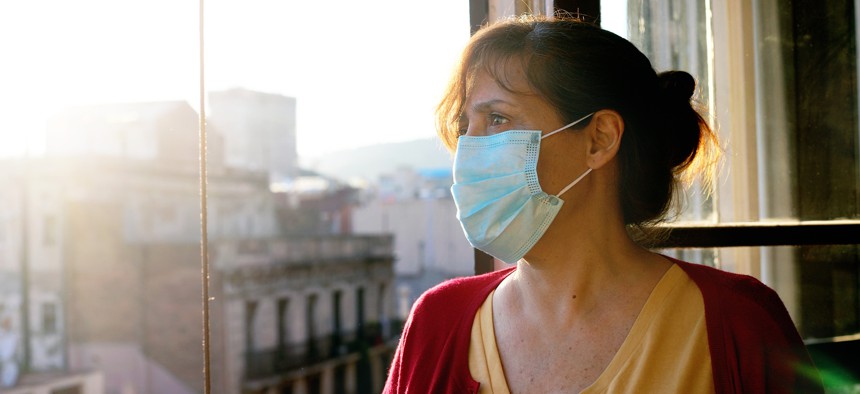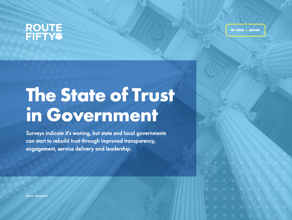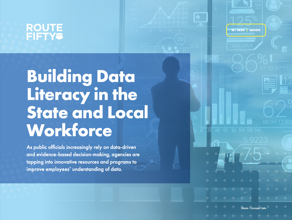Connecting state and local government leaders
COMMENTARY | If you’re confused by the CDC’s new isolation guidelines, you’re not the only one.
This article was originally published in The Atlantic. Sign up for its newsletter.
On Tuesday, the CDC officially dropped the detailed, 1,800-word version of its new isolation guidance for people who have been infected by the coronavirus. So far, the best way I’ve got to sum it up is this: Hunker down for five days instead of the typical 10, then do what you want. ¯\_(ツ)_/¯
Okay, sorry, that’s overly simplistic. Here’s the slightly longer version: You can leave isolation after five days, without a negative test, if you’re not severely sick; you’re not immunocompromised; you’re not in a correctional facility, in a homeless shelter, or on a cruise ship; and you feel that your symptoms are mostly gone, if you had any at all.
Sorry, sorry. There’s actually more. If you do leave isolation after day five, the CDC would like you to, please, until you’re past day 10, still wear a mask everywhere you go, and not eat inside of restaurants, and not mingle with high-risk people, and not travel. Okay, fine, you may travel if you must; just don’t forget that mask. You can test out of isolation, by the way, if you like. First, though, you have to find a test—make sure it’s a rapid antigen test—and take it “towards the end” of your five-day isolation. Just please, still wear that mask until day 10, though remember that negative results can’t rule out infection, and that antigen tests tend to perform best when they’re taken repeatedly over a couple of days, and also, you don’t technically have to test at all.
If you’re overwhelmed, you’re not the only one. In the week and a half since the CDC said that it was planning to update its isolation guidance, I’ve heard almost exclusively harsh reactions from experts, who have criticized the recommendations as convoluted, wishy-washy, and even unscientific. The guidance reads like a nightmarish choose-your-own-adventure book, they’ve told me. It lacks crucial caveats, can’t seem to make up its mind on the role of testing, and asks people to do so, so much before they can get back to daily life. “It’s a hot mess,” one researcher told me. “Unnecessarily confusing,” someone else decreed. “Of all the communication stumbles since February 2020, this one ranks in the top three,” another said.
Such a mess has, unfortunately, become par for the course in the CDC’s handling of the pandemic. The agency is yet again punting the responsibility of infection control to the masses; allowing people’s fates to splinter by timing, by testing, by … whatever is hardly good incentive for the public to read the instructions, much less follow them to a T. At a time when Omicron cases are already shattering records nationwide, the costs of muddled messaging are extraordinarily high. I asked Alison Buttenheim, who studies the intersection of vaccines and human behavior at the University of Pennsylvania, if she thought people would just give up on trying to parse the guidelines and simply improvise their own end-of-isolation rules. “I think people already have,” she said.
Read: Omicron is pushing America into soft lockdown
A pause for some charitableness here. Obviously, we’re in crisis right now, and the CDC has been tasked with an extraordinarily difficult job—debuting new guidance that’s simple, scientific, equitable, and also palatable, based on evidence that’s both limited and rapidly evolving by the day. People have been bandying about the idea of a shortened isolation period for many, many months; such a move could have a hefty social and economic impact right now, as infection rates surge and workplaces, hospitals, and schools across the nation empty out. Briefer isolations, if managed safely, could help keep the country afloat. The new guidelines are meant to do that, Jade Fulce, a public-affairs specialist at the CDC, told me. They “focus on the period when a person is most infectious,” and “facilitate individual and societal needs, return to work, and maintenance of critical infrastructure.” The recommendations are also accompanied by a “consumer-friendly summary,” she said, of how to interpret them.
The experts I spoke with for this story describe the instructions a bit differently—labyrinthine, perhaps even a little brazen and overly crude. As the isolation guidelines stand, they’re relying pretty heavily on a single number for everyone: five, the minimum number of days people should now be isolating, unless they are seriously sick or immunocompromised. It’s true that, on average, SARS-CoV-2 contagiousness does tend to peak fairly early on in infection, right around the time symptoms start (if they do at all), before dropping off precipitously. Past day five, most people don’t seem to carry enough virus to reliably spread it to others. But that’s a coarse population trend, and problematic to apply at the individual level, where there will be dizzying diversity, Katelyn Jetelina, an epidemiologist at the University of Texas Health Science Center at Houston, told me. One study estimates that roughly 30 percent of people may remain infectious after day five.
Some individuals, even ones who aren’t seriously sick, have anecdotally reported finding gobs of virus in their nose well into their second week post-symptom-start, which matches what Susan Butler-Wu, a clinical microbiologist at the University of Southern California, sees with diagnostic tests in her lab. A lot of the data the new recommendations are based on also predate Omicron, which could still upend much of our understanding of transmission dynamics. A five-day isolation might eclipse most people’s window of contagiousness, but certainly not all of them—which means people might be unknowingly reentering social settings while still awash in virus. “I’m very nervous about the idea of ‘five days, whatever, you do you,’” Butler-Wu told me. (Fulce, of the CDC, said that the mask-until-day-10 instruction was meant to address lingering risk. But that hinges on people actually masking, and masking effectively.)
A safe approach to shortened isolations is still achievable, experts told me, but they’d like to see at least two huge amendments to the CDC’s menu of options: a vaccination clause, and a testing requirement, both of which could lower the chances that someone peaces out of isolation prematurely. I wrote about such an abbreviated-isolation model last month. Studies have repeatedly shown that the defensive oomph offered by COVID shots can substantially curb contagiousness; most post-vaccination infections are also asymptomatic or rather mild—cases that, generally speaking, appear to be less infectious overall. It makes sense to give people who are up to date on their shots more wiggle room to exit isolation earlier, especially if that egress is accompanied by “one or two negative test results,” Megan Ranney, an emergency physician at Brown University, told me.
Read: Why are we still isolating vaccinated people for 10 days?
Ironically, those caveats already exist for the agency’s guidance on quarantine: People who are up to date on their shots don’t have to cloister themselves following viral exposures; everyone else still does, though they can test out of quarantine on day five, as long as they mask for another five days after. (A reminder that isolation’s what people do once they know they’re infected; quarantine is what they do after an exposure.)
Last week, when the CDC first announced the shift in guidance in a press release, it didn’t mention testing out of isolation at all, prompting backlash. The longer version of the recommendations published this week somehow made things worse. Although the agency noted that people could test if they wanted to, and said they should act on the results—lengthening isolation after a day-five positive, for instance—the agency did not actively champion testing in the first place. The entire thing reads as deeply self-conflicted, experts told me. “It gives the impression that we don’t know what we’re talking about,” Taison Bell, a critical-care and infectious-disease physician at UVA Health in Virginia, told me. At worst, “I think it actually disincentivizes testing,” Jetelina said. “If you’re positive, you have to stay in isolation longer.”
The CDC did not answer my questions about why vaccination and testing hadn’t been more tightly woven into its new isolation guidelines. But several experts told me they suspected that certain logistical hurdles might have factored in. A vaccination clause, for example, would have added yet more complexity. Not all vaccinated people will reach the same level of protection; anti-infection defenses also naturally ebb over time, while new variants throw certain dynamics into flux. And a testing requirement would be impossible to closely adhere to on large scales, because testing in the United States right now is full-on chaos. People can’t access tests; people can’t afford tests. Some federal aid is coming, but not soon enough, or in sufficient quantity—not to break potentially hundreds of thousands of people out of isolation each day. Even if the CDC were to simply recommend isolation to those who are able to manage it, there could be equity issues, as only the privileged capitalize on the perks of testing, and others are left to navigate transmission in the dark.
Read: Should I just get Omicron over with?
There’s a technological hurdle too. No test result can offer a perfect proxy for contagiousness. PCR laboratory tests can take days to return results, and are so sensitive that they sometimes stay positive past the point at which people stop spewing infectious virus. Rapid, at-home antigen tests, though faster, miss the virus when it’s present only at lower levels, and are easy to mishandle—they risk releasing someone who’s still contagious. The weirdness of Omicron might be muddying those waters further still. Early reports suggest that at least some nose-swab antigen tests are failing to turn positive early on in infection, even while people are symptomatic, positive by PCR, and blazingly contagious—and researchers aren’t yet sure if it’s because of Omicron’s anatomical preferences, or a quirk in how test and variant interact. Either way, if the products can’t catch the virus on its upswing, it’s possible they’ll also struggle on its way back down. The pattern makes Alex McAdam, a pathologist at Boston Children’s Hospital, worried that antigen negatives won’t gift us the stellar “Get out of isolation free” card that many hope they will.
Most experts said that, where possible, they’d still rather see tests being deployed to gauge isolation’s ideal length. Here, a positive result is probably more useful: It says someone definitely shouldn’t be exiting solitude prematurely. The negatives are trickier, though, and if our testing problems persist, it raises questions over whether shorter isolations are worth pursuing before we can fix them. Truncations won’t work if the tests we need to guide them don’t work. Barring good accuracy or availability, as seems to be the case for at least some people now, maybe it’s useful to pivot back to the default: the safety of 10 days, and, as Brown’s Ranney recommends, using symptoms as a guide—“don’t stop isolating if you’re still feeling sick.”
But that ship has sailed. The CDC has, once again, reminded us of its pandemic stance: that even bathed in collective threat, health and risk are personal pursuits; that porous public guidelines are, apparently, an invitation for people to patch the holes as they see fit. The whole point of leaving isolation should be to return to the world—to end a period of solitude. On the other side of infection, though, people still seem to be pretty much on their own.
This article was originally published in The Atlantic. Sign up for its newsletter.
Katherine J. Wu is a staff writer at The Atlantic

NEXT STORY: Lurking Behind Lackluster Jobs Gain Are a Stagnating Labor Market and the Threat of Omicron



